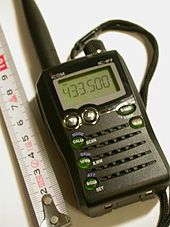Walkie-talkie
![]()
This article or subsequent section is not sufficiently supported by evidence (e.g., anecdotal evidence). Information without sufficient evidence may be removed in the near future. Please help Wikipedia by researching the information and adding good supporting evidence.
Walkie-talkie (from walk 'to walk' and to talk 'to speak') or handheld radio (usually abbreviated HFuG) is a radio that has a mains-independent power supply and is designed so that it can be transported and operated by one person. In amateur radio and professional radio services, such as the authorities and organizations with security tasks, it complements the station radios, which are used as vehicle radio stations (see: mobile radio), land radio stations and relay radio stations. In addition, almost all radios in the field of so-called "Everyman radio" - with the exception of CB radio - are usually also designed as handheld radios for licensing reasons.
Many different handheld radios are used in the amateur radio service. Handheld radios can operate mostly on the 2-m and/or 70-cm bands, and more rarely on the 23-cm, 6-m or 10-m bands. Usually, the radios have only (narrowband) frequency modulation for transmitting (10-meter radios often also have single-sideband modulation.) Amplitude modulation and wideband frequency modulation (broadcast reception) are often also available for receiving. Common handheld radios are standard for relay radio use. Operation is also possible via Echolink, provided a DTMF transceiver is fitted. There are also radios available which are additionally equipped with a module for digital signal transmission. As transmission standard C4FM, DMR and D-STAR are common.

Compact 2 m and 70 cm handheld radio, 2007
Field of application
Handheld radios are not only used on the bike, on fielddays or during walks, but also in the car or at the location of the registered amateur radio station. Amateur radios are rarely also used by BOS radio units on BOS frequencies, although they have no approval for this radio service. Here one takes advantage of the fact that the frequency ranges of modern handheld radios can be extended. Thus, the radios are not only prepared for radio abroad (there are larger amateur bands available), but also for emergency radio.
See also
- Military: Transmitter/receiver, mobile
- Meeting facility
- Radio system of the BOS in Austria
- BOS handheld radio
Questions and Answers
Q: What is a walkie-talkie?
A: A walkie-talkie is a handheld device that can transmit and receive radio signals.
Q: Who developed the early technology for the walkie-talkie?
A: Radio engineer Alfred J. Gross worked on the early technology behind the walkie-talkie between 1934 and 1941.
Q: Who developed the walkie-talkie during World War II?
A: Donald L. Hings and engineering teams at Motorola led by Henryk Magnuski developed the walkie-talkie during World War II.
Q: What is the size of typical walkie-talkies today?
A: Typical walkie-talkies today are phone sized.
Q: What is the function of a push to talk button on a walkie-talkie?
A: The push to talk button on a walkie-talkie allows the user to transmit a message while holding down the button and receive messages when not pressing it.
Q: In what areas are walkie-talkies commonly used today?
A: Walkie-talkies are commonly used in the military, for amateur radio, and for personal use.
Q: Is the walkie-talkie considered an outdated device?
A: No, the walkie-talkie is still widely used today due to its reliability and ease of use in various settings.
Search within the encyclopedia